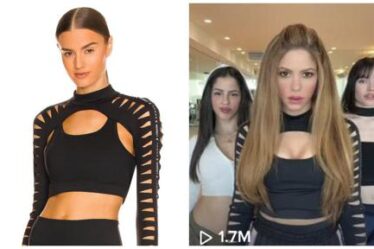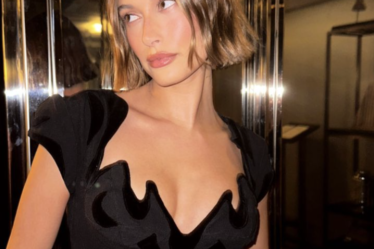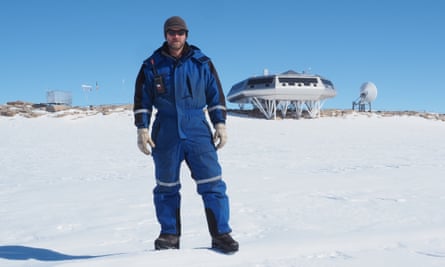
The oyster diver
Lotta Klemming, diver at Klemmings Ostron, Grebbestad, Sweden
Our high season is from November to March. At the start of December the water temperature is 4C, and quickly drops to zero. If we are unlucky, the ice will stop us diving.
Oyster picking is very active. I spend about three hours at a time in the water. My equipment weighs 40kg and my oyster basket will end up weighing the same. I fish for wild oysters – Ostrea edulis (flat oysters) and Magallana gigas (Pacific oysters). We supply them to restaurants around Scandinavia. If there are lots in one place, I can pick them quickly, but I get cold more easily as I am swimming less.
I can’t wear too many layers as it makes moving tricky. I start with thin wool stockings, and add two pairs of woollen socks and a pair of angora gloves, handmade by a woman who lives locally. Next I put on a battery-powered heated undersuit from a company called Santi. Over that goes my Ursuit drysuit. Lots of people in the military wear them. They are made from Cordura (a type of polyester) that is really durable, which I need because oyster diving is rough – I’m on my knees a lot. Finally I put on a full head mask and waterproof gloves. My body never gets wet in the water.
The biggest problem I have is with dry skin. I use a serum and face cream from Edulis cosmetics. It contains oyster extract and is really soothing and hydrating after being in the water. On my lips I use a balm from Nordic brand Decubal.
After diving we drive the boat quickly to the boathouse. There my father makes us a strong coffee, we have sandwiches and I hug my dog to warm up. I have been working with my father for eight years. We’re very similar: if we don’t go diving, we feel something is missing.
The Antarctic scientist
Henri Robert, science liaison officer, International Polar Foundation (IPF)
Our season on board the polar research station, Princess Elisabeth Antarctica, runs from November to February. It is a real building on a granite ridge surrounded by ice at the edge of the Sør Rondane mountains, 125 miles from the coast of Queen Maud Land, in eastern Antarctica. When we arrive it’s -20C; later in the year it warms up to -5C.
We get there from Cape Town, and the IPF has an office in the city where all the polar clothing is stored. A couple of days before deployment, people come to the office to choose their clothes – everything from thermal underwear and balaclavas to down jackets and windproof trousers.
My greatest tip is never underestimate the wind and the cold. Conditions can deteriorate quickly and you can easily find yourself in a white-out. This is where everything turns white around you and you can’t see your feet. You must always think of the worst conditions and be prepared for them. Bring extra gloves, a few hand warmers and a flask of tea.
Inside the station it’s 20C. We run off solar panels and wind turbines. We’re the first and only zero-emissions station.
Outside there is no humidity; it’s a very dry, cold climate. The fact that the air is mostly dry helps a lot with insulation: the cold does not get to you if you are well dressed for outside conditions.
Our biggest enemy is the wind. On a nice sunny day with no wind, even at -12C you can work outside in a T-shirt if you stay active. It’s similar to being on a ski slope. However, if there is no sun and the wind blows a bit, you immediately feel it.
I’ll wear long johns, then a cotton T-shirt or shirt plus a jumper and trousers or jeans. Over that I’ll wear a ski jacket from Sprayway, and trousers from Millets, which are both insulated and waterproof. We have special boots from Extreme Planet, a brand designed by explorer Alain Hubert. They are made for the climate we work in. They are insulated to -30C, have a really thick sole and don’t crack in the cold. We get them on request from the IPF. I like to wear mine with merino wool socks: they are not that thick but they are the best for warmth.
I wear sunglasses as the light is so strong. They also stop ice crystals forming on my eyelashes. We are right beneath the the hole in the ozone, so the sunlight is really concentrated. Within a couple of hours you can get sun burned, so I always wear SPF50 cream. After being outdoors I’ll use an aftersun, hand cream and body lotion that I picked up in the airport in Cape Town.
I live in Belgium and the return to normality can be quite hard. We call it the “Antarctic blues”. Out here we live in a bubble: we don’t have money and never go shopping. My wife is a former biologist so she understands. Our tradition when I get home is to book a stay at a hotel with a thermal spa. It’s the complete opposite to my life here. I like it: it’s like turning a page.
The open-air pool manager
Karis Musser, duty manager, Jubilee pool, Penzance, Cornwall
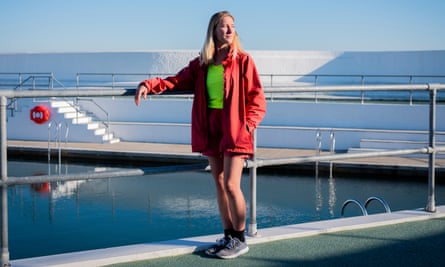
All year round, I start each day with a swim in the sea. Then I’ll go into work and get changed. I don’t shower; I just splash my face with water because I like the feel of salt on my skin. I’ll put suncream on my face though. I like Bondi Sands SPF50 and I use a Burt’s Bees lip balm. The main Jubilee pool is unheated and filled with sea water at high tide. Sometimes we get splashed by the waves. I love watching the light change throughout the day. Evening is my favourite: it goes purple and pink and the sea turns golden.
My early morning swim really gets my circulation going, which helps with being out in the cold. I usually eat the same thing to fuel me. I start my day with Greek yoghurt, granola and coffee, and then have a cup of tea and an apple at 11am. For lunch I’ll bring in a sandwich, crisps and fruit. The canteen gives us free hot drinks and I’ll sip herbal tea throughout the afternoon.
I wear thermals and the Jubilee pool branded kit from the Royal Lifesaving Society – a windproof, water-resistant tracksuit and a fleece-lined waterproof jacket. I also have a waterproof and fleece-lined robe from Wild Moose. We’re not allowed to wear things like wellington boots. You need to be able to ditch your shoes easily. I like trainers from Skechers.
I grew up in the tropics and lived in LA, so I used to be scared of the cold. Outdoor swimming helped me overcome it; it’s also really helped me with anxiety and panic attacks. You learn to control your body in the water.
We haven’t had any hypothermia cases this year. I coach people how to do cold water swimming safely: you can stay in the water for one minute per degree, so if it’s 4C you can stay in for four minutes. You start by splashing water on your face: that slows down the heart rate. I talk them through how to breathe deeply. We don’t allow anyone to dive in.
I’m always damp, so my skin suffers. I put Carmex balm on my nose a lot. And I wear suncream every day. As soon as I get home, my face gets too hot – it’s like having a fever. I have to sit still for a bit, have another herbal tea and read. Then I’ll have a shower, and apply a moisturiser all over my body. I like the Cien Q10 from Lidl. It’s cheap and it works. Then I’ll make something warming for dinner such as a curry or chilli.
I used to work at a leisure centre but the environment was really fake. The lido is different: I know every customer. Outdoor swimming brings people together. It’s all about community.
The cold storage worker
Aldrin Jeswinth, systems manager at J S Davidson Cold Storage, Peterborough
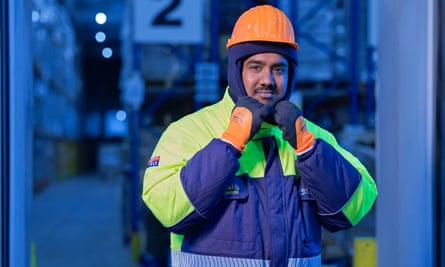
After 20 minutes in a -20C freezer, frost forms on your face. But you can’t feel it as you are numb. Some people wear neckerchiefs or balaclavas, but frost forms wherever your breath causes moisture on the cloth. You shouldn’t spend more than 50 minutes inside the unit without taking a 10-minute break.
Our warehouses are huge. There is one large freezer unit of 43,200 cubic meters. You enter through insulated doors. They open and close very quickly to stop hot air and moisture entering.
Shifts run from 6am to 2pm and 2pm to 10pm. If you are picking, you are given a list of things to source for a client. You are always moving so stay warmer than if you are sitting on a forklift.
We wear Goldfreeze clothing, which is insulated and designed for working in freezer units. The gloves are neoprene, with a grain leather palm and a special Thinsulate lining designed for extreme temperatures. The worst part is getting cold feet and hands. Some people wear two pairs of gloves.
The longest-serving member of staff has been here 37 years. The shortest, 30 minutes. It’s really tough. To succeed you just have to get through the pain barrier.

